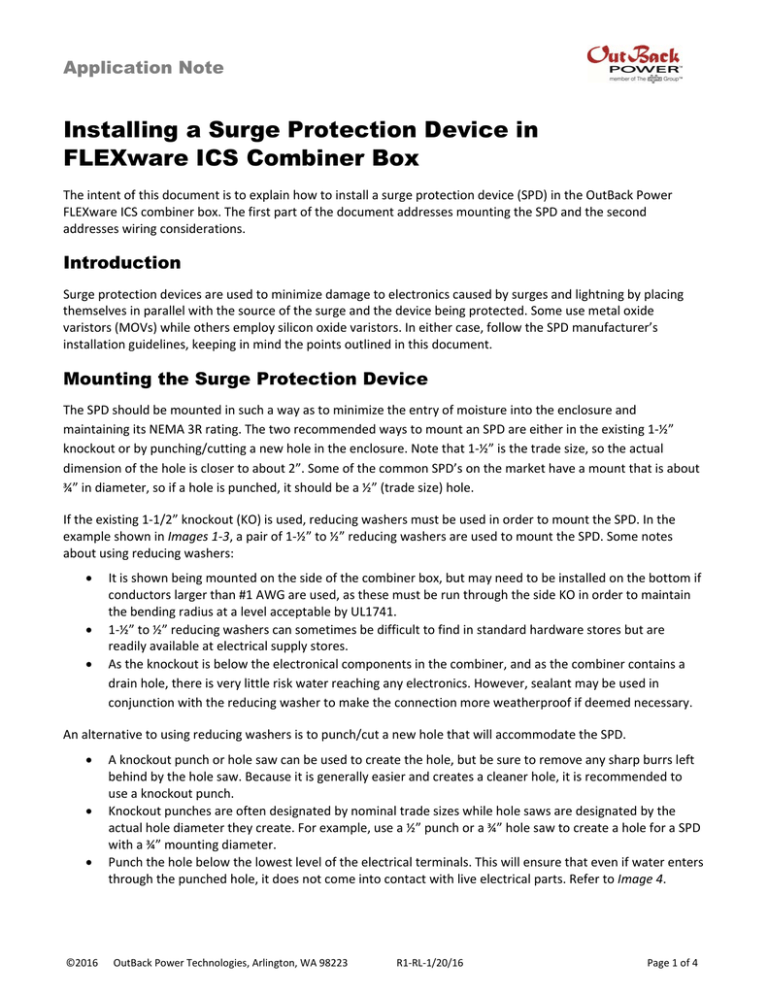
Application Note
Installing a Surge Protection Device in
FLEXware ICS Combiner Box
The intent of this document is to explain how to install a surge protection device (SPD) in the OutBack Power FLEXware ICS combiner box. The first part of the document addresses mounting the SPD and the second addresses wiring considerations. Introduction
Surge protection devices are used to minimize damage to electronics caused by surges and lightning by placing themselves in parallel with the source of the surge and the device being protected. Some use metal oxide varistors (MOVs) while others employ silicon oxide varistors. In either case, follow the SPD manufacturer’s installation guidelines, keeping in mind the points outlined in this document. Mounting the Surge Protection Device
The SPD should be mounted in such a way as to minimize the entry of moisture into the enclosure and maintaining its NEMA 3R rating. The two recommended ways to mount an SPD are either in the existing 1‐½” knockout or by punching/cutting a new hole in the enclosure. Note that 1‐½” is the trade size, so the actual dimension of the hole is closer to about 2”. Some of the common SPD’s on the market have a mount that is about ¾” in diameter, so if a hole is punched, it should be a ½” (trade size) hole. If the existing 1‐1/2” knockout (KO) is used, reducing washers must be used in order to mount the SPD. In the example shown in Images 1‐3, a pair of 1‐½” to ½” reducing washers are used to mount the SPD. Some notes about using reducing washers:
It is shown being mounted on the side of the combiner box, but may need to be installed on the bottom if conductors larger than #1 AWG are used, as these must be run through the side KO in order to maintain the bending radius at a level acceptable by UL1741. 1‐½” to ½” reducing washers can sometimes be difficult to find in standard hardware stores but are readily available at electrical supply stores. As the knockout is below the electronical components in the combiner, and as the combiner contains a drain hole, there is very little risk water reaching any electronics. However, sealant may be used in conjunction with the reducing washer to make the connection more weatherproof if deemed necessary. An alternative to using reducing washers is to punch/cut a new hole that will accommodate the SPD.
A knockout punch or hole saw can be used to create the hole, but be sure to remove any sharp burrs left behind by the hole saw. Because it is generally easier and creates a cleaner hole, it is recommended to use a knockout punch. Knockout punches are often designated by nominal trade sizes while hole saws are designated by the actual hole diameter they create. For example, use a ½” punch or a ¾” hole saw to create a hole for a SPD with a ¾” mounting diameter. Punch the hole below the lowest level of the electrical terminals. This will ensure that even if water enters through the punched hole, it does not come into contact with live electrical parts. Refer to Image 4. ©2016 OutBack Power Technologies, Arlington, WA 98223 R1‐RL‐1/20/16 Page 1 of 4 Application Note
In either case, make sure not to over‐torque the SPD such that its rubber washer bulges or is otherwise prevented from forming a proper seal. Wiring the Surge Protection Device
Wiring the SPD is straightforward but there are some details to observe. The first is to ensure the terminal bars are utilized properly, as there are restrictions on how they can be wired:
The SPD will come with wires for both positive (red) and negative (black) and they should be landed in the combining terminal blocks of corresponding polarity. Refer to Images 3‐4. o It is critical to land the wires in the open terminal on the PV input side of the terminal block. Refer to Image 5 (macro photo). Do not install the SPD wires into terminals occupied by PV input wires nor the output terminals. The green ground wire of the SPD is installed on the ground bar in the combiner. Ensure that all terminals are tightened to the appropriate torques, as shown in the installation manual for the combiner box. Finally, to maintain effectiveness of the SPD, do not cut its wires so short that sharp bends are required in order to terminate the conductors; larger bend radii optimize performance of the SPD. See Images 3‐4. Image 1: Installing SPD using reducing washers.
Image 2: Installing SPD using reducing washers.
©2016 OutBack Power Technologies, Arlington, WA 98223 R1‐RL‐1/20/16 Page 2 of 4 Application Note
Image 3: SPD installed with reducing washers.
Image 4: SPD installed in a newly punched hole.
Image 5: SPD must be wired to their own dedicated terminals. This photo shows the six pre‐wired PV+ wires and an example system consisting of five strings of PV circuits, hence only five PV‐ wires. ©2016 OutBack Power Technologies, Arlington, WA 98223 R1‐RL‐1/20/16 Page 3 of 4 Application Note
About OutBack Power Technologies
OutBack Power Technologies is a leader in advanced energy conversion technology. OutBack products
include true sine wave inverter/chargers, maximum power point tracking charge controllers, and system
communication components, as well as circuit breakers, batteries, accessories, and assembled systems.
Grid/Hybrid™
As a leader in off-grid energy systems designed around energy storage, OutBack Power is an innovator in
Grid/Hybrid system technology, providing the best of both worlds: grid-tied system savings during normal or
daylight operation, and off-grid independence during peak energy times or in the event of a power outage or
an emergency. Grid/Hybrid systems have the intelligence, agility and interoperability to operate in multiple
energy modes quickly, efficiently, and seamlessly, in order to deliver clean, continuous and reliable power to
residential and commercial users while maintaining grid stability.
Contact Information
Address:
Corporate Headquarters
17825 – 59th Avenue N.E.
Suite B
Arlington, WA 98223 USA
European Office
Hansastrasse 8
D-91126
Schwabach, Germany
Telephone:
+1.360.435.6030
+1.360.618.4363 (Technical Support)
+1.360.435.6019 (Fax)
+49.9122.79889.0
+49.9122.79889.21 (Fax)
Email:
Support@outbackpower.com
Website:
http://www.outbackpower.com
Disclaimer
UNLESS SPECIFICALLY AGREED TO IN WRITING, OUTBACK POWER TECHNOLOGIES:
(a) MAKES NO WARRANTY AS TO THE ACCURACY, SUFFICIENCY OR SUITABILITY OF ANY
TECHNICAL OR OTHER INFORMATION PROVIDED IN ITS MANUALS OR OTHER DOCUMENTATION.
(b) ASSUMES NO RESPONSIBILITY OR LIABILITY FOR LOSS OR DAMAGE, WHETHER DIRECT,
INDIRECT, CONSEQUENTIAL OR INCIDENTAL, WHICH MIGHT ARISE OUT OF THE USE OF SUCH
INFORMATION. THE USE OF ANY SUCH INFORMATION WILL BE ENTIRELY AT THE USER’S RISK.
OutBack Power Technologies cannot be responsible for system failure, damages, or injury resulting from
improper installation of their products.
Information included in this manual is subject to change without notice.
Notice of Copyright
Application Note © 2016 by OutBack Power Technologies. All Rights Reserved.
Trademarks
OutBack Power, the OutBack Power logo, FLEXpower ONE, Grid/Hybrid, and OPTICS RE are trademarks
owned and used by OutBack Power Technologies, Inc. The ALPHA logo and the phrase “member of the
Alpha Group” are trademarks owned and used by Alpha Technologies Inc. These trademarks may be
registered in the United States and other countries.
©2016 OutBack Power Technologies, Arlington, WA 98223 R1‐RL‐1/20/16 Page 4 of 4



